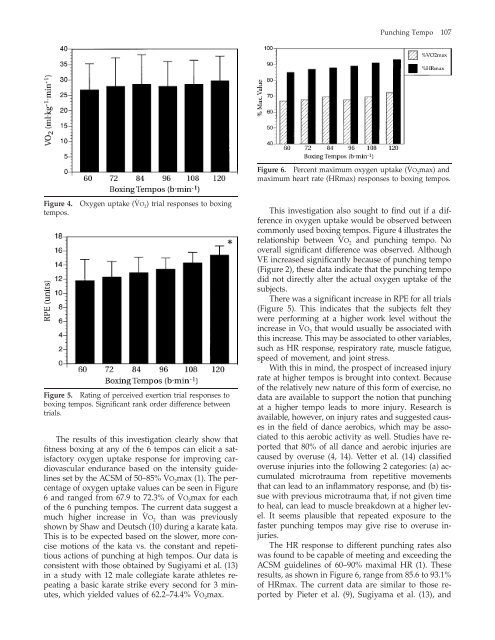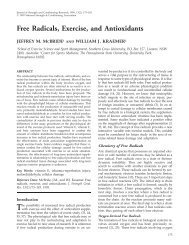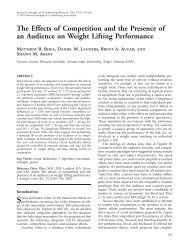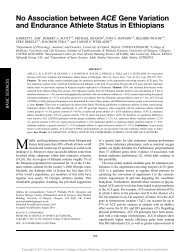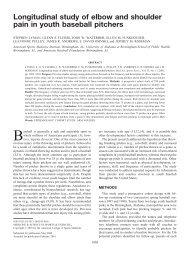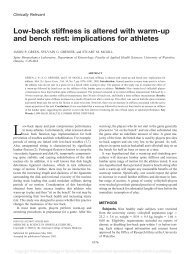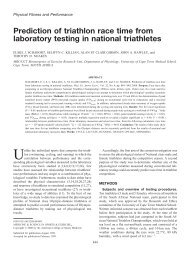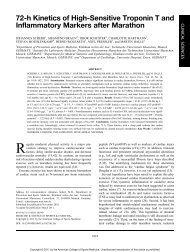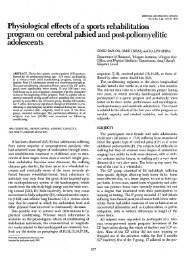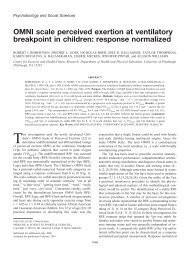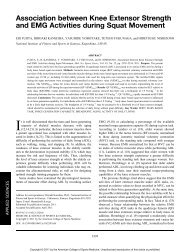Cardiovascular Response to Punching Tempo - Setanta College
Cardiovascular Response to Punching Tempo - Setanta College
Cardiovascular Response to Punching Tempo - Setanta College
You also want an ePaper? Increase the reach of your titles
YUMPU automatically turns print PDFs into web optimized ePapers that Google loves.
Figure 4. Oxygen uptake (V˙ O2) trial responses <strong>to</strong> boxing<br />
tempos.<br />
Figure 5. Rating of perceived exertion trial responses <strong>to</strong><br />
boxing tempos. Significant rank order difference between<br />
trials.<br />
The results of this investigation clearly show that<br />
fitness boxing at any of the 6 tempos can elicit a satisfac<strong>to</strong>ry<br />
oxygen uptake response for improving cardiovascular<br />
endurance based on the intensity guidelines<br />
set by the ACSM of 50–85% V˙ O2max (1). The percentage<br />
of oxygen uptake values can be seen in Figure<br />
6 and ranged from 67.9 <strong>to</strong> 72.3% of V˙ O2max for each<br />
of the 6 punching tempos. The current data suggest a<br />
much higher increase in V˙ O2 than was previously<br />
shown by Shaw and Deutsch (10) during a karate kata.<br />
This is <strong>to</strong> be expected based on the slower, more concise<br />
motions of the kata vs. the constant and repetitious<br />
actions of punching at high tempos. Our data is<br />
consistent with those obtained by Sugiyami et al. (13)<br />
in a study with 12 male collegiate karate athletes repeating<br />
a basic karate strike every second for 3 minutes,<br />
which yielded values of 62.2–74.4% V˙ O2max.<br />
<strong>Punching</strong> <strong>Tempo</strong> 107<br />
Figure 6. Percent maximum oxygen uptake (V˙ O2max) and<br />
maximum heart rate (HRmax) responses <strong>to</strong> boxing tempos.<br />
This investigation also sought <strong>to</strong> find out if a difference<br />
in oxygen uptake would be observed between<br />
commonly used boxing tempos. Figure 4 illustrates the<br />
relationship between V˙ O2 and punching tempo. No<br />
overall significant difference was observed. Although<br />
VE increased significantly because of punching tempo<br />
(Figure 2), these data indicate that the punching tempo<br />
did not directly alter the actual oxygen uptake of the<br />
subjects.<br />
There was a significant increase in RPE for all trials<br />
(Figure 5). This indicates that the subjects felt they<br />
were performing at a higher work level without the<br />
increase in V˙ O2 that would usually be associated with<br />
this increase. This may be associated <strong>to</strong> other variables,<br />
such as HR response, respira<strong>to</strong>ry rate, muscle fatigue,<br />
speed of movement, and joint stress.<br />
With this in mind, the prospect of increased injury<br />
rate at higher tempos is brought in<strong>to</strong> context. Because<br />
of the relatively new nature of this form of exercise, no<br />
data are available <strong>to</strong> support the notion that punching<br />
at a higher tempo leads <strong>to</strong> more injury. Research is<br />
available, however, on injury rates and suggested causes<br />
in the field of dance aerobics, which may be associated<br />
<strong>to</strong> this aerobic activity as well. Studies have reported<br />
that 80% of all dance and aerobic injuries are<br />
caused by overuse (4, 14). Vetter et al. (14) classified<br />
overuse injuries in<strong>to</strong> the following 2 categories: (a) accumulated<br />
microtrauma from repetitive movements<br />
that can lead <strong>to</strong> an inflamma<strong>to</strong>ry response, and (b) tissue<br />
with previous microtrauma that, if not given time<br />
<strong>to</strong> heal, can lead <strong>to</strong> muscle breakdown at a higher level.<br />
It seems plausible that repeated exposure <strong>to</strong> the<br />
faster punching tempos may give rise <strong>to</strong> overuse injuries.<br />
The HR response <strong>to</strong> different punching rates also<br />
was found <strong>to</strong> be capable of meeting and exceeding the<br />
ACSM guidelines of 60–90% maximal HR (1). These<br />
results, as shown in Figure 6, range from 85.6 <strong>to</strong> 93.1%<br />
of HRmax. The current data are similar <strong>to</strong> those reported<br />
by Pieter et al. (9), Sugiyama et al. (13), and


